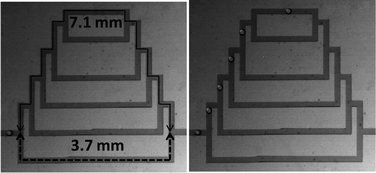Bubbles navigating through networks of microchannels†
Abstract
This paper describes the behavior of bubbles suspended in a carrier liquid and moving within microfluidic networks of different connectivities. A single-phase continuum fluid, when flowing in a network of channels, partitions itself among all possible paths connecting the inlet and outlet. The flow rates along different paths are determined by the interaction between the fluid and the global structure of the network. That is, the distribution of flows depends on the fluidic resistances of all channels of the network. The movement of bubbles of gas, or droplets of liquid, suspended in a liquid can be quite different from the movement of a single-phase liquid, especially when they have sizes slightly larger than the channels, so that the bubbles (or droplets) contribute to the fluidic resistance of a channel when they are transiting it. This paper examines bubbles in this size range; in the size range examined, the bubbles are discrete and do not divide at junctions. As a consequence, a single bubble traverses only one of the possible paths through the network, and makes a sequence of binary choices (“left” or “right”) at each branching intersection it encounters. We designed networks so that, at each junction, a bubble enters the channel into which the volumetric flow rate of the carrier liquid is highest. When there is only a single bubble inside a network at a time, the path taken by the bubble is, counter-intuitively, not necessarily the shortest or the fastest connecting the inlet and outlet. When a small number of bubbles move simultaneously through a network, they interact with one another by modifying fluidic resistances and flows in a time dependent manner; such groups of bubbles show very complex behaviors. When a large number of bubbles (sufficiently large that the volume of the bubbles occupies a significant fraction of the volume of the network) flow simultaneously through a network, however, the collective behavior of bubbles—the fluxes of bubbles through different paths of the network—can resemble the distribution of flows of a single-phase fluid.


 Please wait while we load your content...
Please wait while we load your content...